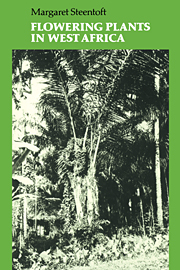Book contents
- Frontmatter
- Contents
- Introduction
- List of symbols and abbreviations
- 1 Species associations
- 2 Vegetation in West Africa
- 3 Annonaceae – soursop family
- 4 Amaranthaceae – amaranth family
- 5 Cucurbitaceae – gourd family
- 6 Ochnaceae – ironwood family
- 7 Combretaceae – afara family
- 8 Guttiferae (Clusiaceae) – butter tree family
- 9 Sterculiaceae – cocoa family
- 10 Bombacaceae – silk cotton family
- 11 Malvaceae – cotton family
- 12 Euphorbiaceae – cassava family
- 13 Caesalpiniaceae – pride of Barbados family
- 14 Mimosaceae – Acacia family
- 15 Papilionaceae – cowpea family
- 16 Ulmaceae – afefe family
- 17 Moraceae – mulberry family
- 18 Meliaceae – mahogany family
- 19 Sapindaceae – akee apple family
- 20 Anacardiaceae – cashew nut family
- 21 Sapotaceae – sheabutternut family
- 22 Apocynaceae – frangipani family
- 23 Asclepiadaceae – blood flower or milkweed family
- 24 Rubiaceae – abura family
- 25 Compositae (Asteraceae) – Tridax family
- 26 Solanaceae – tomato family
- 27 Convolvulaceae – sweet potato family
- 28 Bignoniaceae – jacaranda family
- 29 Acanthaceae – Thunbergia family
- 30 Verbenaceae – teak family
- 31 Labiatae (Lamiaceae) – Hausa potato family
- 32 Commelinaceae – day flower family
- 33 Zingiberaceae – ginger family
- 34 Marantaceae – (West Indian) arrowroot family
- 35 Liliaceae – lily family
- 36 Araceae – cocoyam family
- 37 Palmae (Arecaceae) – palm family
- 38 Orchidaceae – orchid family
- 39 Cyperaceae – sedge family
- 40 Gramineae (Poaceae) – grass family
- General bibliography
- Index of family, generic and common names
23 - Asclepiadaceae – blood flower or milkweed family
Published online by Cambridge University Press: 02 November 2009
- Frontmatter
- Contents
- Introduction
- List of symbols and abbreviations
- 1 Species associations
- 2 Vegetation in West Africa
- 3 Annonaceae – soursop family
- 4 Amaranthaceae – amaranth family
- 5 Cucurbitaceae – gourd family
- 6 Ochnaceae – ironwood family
- 7 Combretaceae – afara family
- 8 Guttiferae (Clusiaceae) – butter tree family
- 9 Sterculiaceae – cocoa family
- 10 Bombacaceae – silk cotton family
- 11 Malvaceae – cotton family
- 12 Euphorbiaceae – cassava family
- 13 Caesalpiniaceae – pride of Barbados family
- 14 Mimosaceae – Acacia family
- 15 Papilionaceae – cowpea family
- 16 Ulmaceae – afefe family
- 17 Moraceae – mulberry family
- 18 Meliaceae – mahogany family
- 19 Sapindaceae – akee apple family
- 20 Anacardiaceae – cashew nut family
- 21 Sapotaceae – sheabutternut family
- 22 Apocynaceae – frangipani family
- 23 Asclepiadaceae – blood flower or milkweed family
- 24 Rubiaceae – abura family
- 25 Compositae (Asteraceae) – Tridax family
- 26 Solanaceae – tomato family
- 27 Convolvulaceae – sweet potato family
- 28 Bignoniaceae – jacaranda family
- 29 Acanthaceae – Thunbergia family
- 30 Verbenaceae – teak family
- 31 Labiatae (Lamiaceae) – Hausa potato family
- 32 Commelinaceae – day flower family
- 33 Zingiberaceae – ginger family
- 34 Marantaceae – (West Indian) arrowroot family
- 35 Liliaceae – lily family
- 36 Araceae – cocoyam family
- 37 Palmae (Arecaceae) – palm family
- 38 Orchidaceae – orchid family
- 39 Cyperaceae – sedge family
- 40 Gramineae (Poaceae) – grass family
- General bibliography
- Index of family, generic and common names
Summary
Shrubs and twiners, occasionally stem succulents resembling cacti superficially, e.g. Caralluma dalzielii, sometimes seen in gardens. Milky juice is always present, though not always copiously so (Leptadenia), while leaves are simple, exstipulate and whorled or opposite, with flat or curved ptyxis. Some genera are, however, leafless, and in a few others the leaves are very short lived. There are cymes of complex five-part flowers, in which each anther contains one or two pollen masses (pollinia) in each loculus, and the paired carpels are joined only distally by the styles. The fruit is a pair of follicles (or a single one by abortion), containing plumed seeds.
In West Africa, the family is well represented in savanna and sahel, but only a few species are common in forest. Many of our species occur also in similar habitats elsewhere in tropical Africa, but within West Africa most of the species have very local distribution.
Only sodom apple (Calotropis procera) and blood flower (Asclepias curassavica) seem to have been introduced successfully into West Africa, blood flower, generally seen as a small shrub, being common in gardens and very suitable for the investigation of the flowers.
Leptadenia and Sarcostemma are ecologically important genera on the sahel zone and driest savannas, possessing also distinctive habits. Leptadenia consists of two species of twining shrubs and an erect one. This last is L. pyrotechnica, which produces tiny leaves, a few at a time, on its new, wiry stems.
- Type
- Chapter
- Information
- Flowering Plants in West Africa , pp. 205 - 209Publisher: Cambridge University PressPrint publication year: 1988



